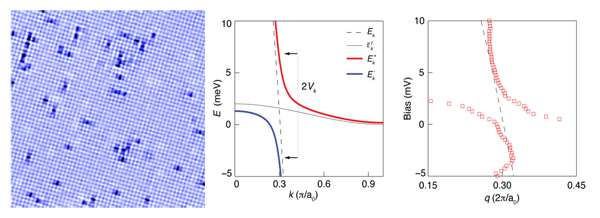Topological Kondo Insulators
Research Status
In a crystal with a sub-lattice of localized f-electron states, the Kondo effect generates a heavy-fermion band structure. At high temperatures, a conventional (light) electronic band coexists with localized f-electron states on each magnetic atom. At lower temperatures, hybridization between this light band and the f-electron states results in opening a hybridization gap ΔHF(k), and its splitting into two new very flat bands with greatly enhanced density-of-electronic-states N(E) within just a few meV of EF. We developed a dilution-refrigerator-based mK SISTM instrument for mapping simultaneously the r-space and k-space electronic structure of heavy-fermion systems at temperatures down to 20 mK. Demonstration of the feasibility of this approach for visualizing heavy-fermion formation, and measuring heavy-fermion band-structures, launched the field of STM studies of heavy fermions (Nature 465, 570 (2010)).

Fig. 4 A) URu2Si2 surface with Th substitution sites dark; B) the expected heavy-fermion band formation due to hybridization of the localized/magnetic Ur electrons with delocalized Ru electrons; C) our QPI measured heavy-fermion band formation in of URu2Si2.
Research Plans
The capability to image heavy fermions (Fig. 4) opens exciting new avenues for research into strongly entangled electronic quantum matter.
a) The theory of topological Kondo insulators (TKI) postulates a strongly anisotropic ΔHF(k) that inverts the parity of bulk heavy-fermion states. The resulting prediction is for heavy-fermion topological surface states to appear at three points of the surface BZ. To explore these phenomena, we plan to apply high-resolution heavy-fermion visualization technique at millikelvin temperatures to measure the k-space structure of ΔHF(k) of the TKI SmB6.
b) Such mK SISTM techniques also represent an exciting opportunity to achieve direct visualization of electronic quantum criticality. When quantum fluctuations become sufficiently strong, heavy-fermion systems often undergo a quantum phase transition to a new ground state. Indeed, understanding this type of quantum critical electronic matter is one of the key challenges of condensed matter physics. YbRh2Si2 is a heavy-fermion system with a QCP near B=0.66 Tesla (and no superconductivity). We plan to apply mK visualization techniques in magnetic field, to determine the heavy-fermion band structure, and to characterize the quasiparticles in the quantum critical regime surrounding the antiferromagnetic QCP of YbRh2Si2.
